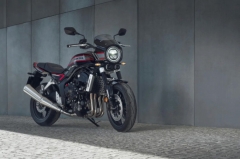Kawasaki debuts first full-sized electric motorcycles in the UK
The Kawasaki Ninja and Z e-1 present themselves as proof-of-concept of Team Green’s electric endeavors.

As electric motorcycles become increasingly popular, it's only natural that well-established motorcycle manufacturers would want to enter the market currently dominated by startups. Leading the charge among Japanese giants is Kawasaki, with Team Green making their debut in this exciting electric motorcycle industry.
Kawasaki has unveiled its debut full-sized electric motorcycles, namely the Ninja e-1 and Z e-1, set to hit the market in 2024. These bikes draw strong inspiration from the popular Ninja 400 and Z400 models but introduce an electrifying twist to the lineup. Targeting the entry-level segment, they essentially serve as counterparts to 125cc internal combustion engine (ICE) motorcycles. Both are equipped with air-cooled, interior permanent magnet synchronous motors, delivering a peak output of 12 hp (9 kW; with a continuous output of 6 kW) and 41 Nm of torque. These specs translate into an estimated top speed of approximately 100 km/h.

It's important to highlight that the Ninja e-1 and Z e-1 can maintain their top speed of 100 km/h for approximately 15 seconds, after which they settle at around 85 km/h. This performance is made possible by Kawasaki's innovative E-Boost feature, a temporary performance boost that enables the higher top speed. This feature proves particularly useful in urban environments, as Team Green asserts that E-Boost enhances acceleration, resulting in improved overtaking capabilities.
Among the noteworthy rider features are the inclusion of two power modes, namely road and eco, as well as a walk mode designed to assist with parking. With the walk mode engaged, a twist of the throttle in the right direction propels the motorcycle forward, while a twist in the opposite direction facilitates backward movement. These features are conveniently accessible through Kawasaki's familiar 4.3-inch TFT instrument cluster, albeit with a revised layout.

Regarding the range, both electric motorcycles come equipped with two Li-ion battery packs that offer a combined range of 70 kilometers. While this range might not appear impressive, there's a silver lining – you have the option to swap out depleted batteries for fresh ones when needed. Alternatively, you can choose to wait for approximately 3.7 hours to fully recharge each battery. Given that real-world range could be even lower, the battery swapping option seems like a more practical choice.
The Kawasaki electric motorcycles are currently targeted primarily at the European and British markets, and this strategic choice is partly reflected in their entry-level specifications, which align with the A1 license category requirements in those regions. As for pricing, it's still awaiting confirmation at the time of this writing. Of course, don’t expect to see this bikes enter the Philippines anytime soon, as we’re still a ways away from having the infrastructure needed to make EVs a practical choice for motorcyclists.
Latest News
-
Take a look at the new Honda CB1000F / News
Honda has revealed the production-spec CB1000F, blending retro style with Hornet-based performance and modern tech. Expected to hit UK showrooms in early 2026.
-
Ducati launches all-new Hypermotard V2 with cutting-edge tech / News
The Hypermotard V2 keeps its aggressive stance and signature beak while bringing sharper design and modern electronics.
-
2026 Kawasaki Z650 S gets more aggressive styling and premium tech / News
The 2026 Kawasaki Z650 S adds new styling, updated tech, and the same dependable 649cc engine loved by middleweight riders worldwide.





